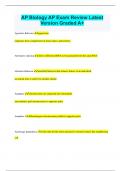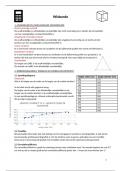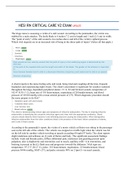Chapter 1: Preliminaries
Microeconomics: branch of economics that deals with the behavior of individual economic
units as well as the markets that these units comprise
Consumers:
- Trade-offs in the purchase of more of some goods for less of others
- Trade-off between current consumption and future consumption
Firms:
- Trade-offs in what to produce
- Trade-offs in the resources to use in production
Markets: a market is the collection of buyers and sellers that, through their actual or
potential interactions determine the price of a product or set of products ≠ industry!!
The extent of a market refers to the boundaries of a market, both geographical and in terms
of range of products produced and sold within it.
Geographic boundaries: highly localized market vs global market
Product range: are products used for the same or a different purpose?
Why is it important?
1.) Company decisions who are the actual and potential competitors of our company?
2.) Public policy decisions Should we allow this merger?
Chapter 2: The basics of supply and demand
,Chapter 3: Consumer behavior
Consumer theory
consumers choose the best market basket (or bundle) they can afford
Can afford budget constraints
Best consumer preferences
optimal choice = combination “can afford” + “best”
Price-consumption curve income-consumption curve
Market baskets
or a market bundle is a list with specific quantities of one or more goods
Example: units of food and units of clothing per month
Method of measurement largely arbitrary units
Two-goods assumption? Good 2 as “composite good”
-> Composite good = combining more goods into one good
Consumer preferences
1.) Assumptions about preferences
4 basic assumptions: completeness, transivity, more is better than less
- Completeness: for any two market baskets A & B, a consumer will (1) prefer A to B,
(2) prefer B to A, or (3) be indifferent between the two. !! Preferences ignore costs !!
- Transitivity: if a consumer prefers market basket A to B, and prefers market basket B
to C, then the consumer also prefers market basket A to C. !! Necessary for
consistency !!
, - More is better than less (non-satiation): consumers always prefer more of any good
to less. They are never satisfied; more is always better. !! Exception: bads !!
- Diminishing marginal rate of substitution: indifference curve is convex if MRS
diminishes along the curve
2.) Indifference curves
Indifference curve: curve representing all combinations
of market baskets that provide a consumer with the
same level of satisfaction
Indifference map: graph containing a set of indifference
curves showing the market baskets among which a
consumer is indifferent
3 properties of indifference curves:
- Downward sloping: otherwise, the assumption ‘more is better than less’ about
preferences is violated
- Cannot intersect: otherwise the assumption ‘transivity’ of preferences is violated
- Convex: indifference curves are usually convex or bowed inward. They get flatter if
you move further to the right “as food consumption increases, the slope of the
indifference curve falls in magnitude”. Indifference curve is convex if the MRS
diminishes along the curve
3.) Marginal Rate of Substitution (MRS)
maximum amount of a good that a consumer is
willing to give up in order to obtain one additional
unit of another good
- Negative of the slope of the indifference curve at
any point
- MRS of food F for clothing C: - (-6/1) = 6
- Magnitude of the slope of the indifference curve
, 4.) Perfect substitutes
two goods for which the MRS is a constant number
MRS constant
Indifference curves are linear and have a constant slope
Examples:
- Red pencils and blue pencils
- Mastercard or Visa credit cards
- Orange juice and apple juice
- Coca-Cola and Pepsi
5.) Perfect complements
two goods for which the MRS is zero or infinite
MRS zero or infinite
Always consumed together in fixed proportion (not always
1 : 1)
Indifference curves are L – shaped
Examples:
- Right shoes and left shoes
- Computers and operating systems
- Portable gaming device and batteries
6.) Neutrals
neutral good: a good that the consumer does not care
about
Example: hamburgers (like) and soft drinks (neutral)
“Satisfaction of the consumer depends entirely on how
many hamburgers he has. No matter how many soft drink
the consumer has. His satisfaction will remain the same.”
7.) Bads
goods that the consumer does not like good for
which less is preferred rather than more
Indifference curves have a positive slope
Example: air pollution, hamburger and soft drinks example










